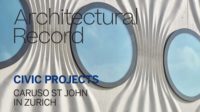Long before the athletes go for the gold at the 2010 Olympic Games in Vancouver, native son Omer Arbel won the commission to design the medals the winning competitors will sport around their necks. Trained as an architect, Arbel divides his time equally between designing buildings and objects since founding his own firm, Omer Arbel Office, in 2005. The medals, however, are a first for Arbel, whose industrial design projects consist mainly of furniture and lighting. “We’ve never done anything like this before,” he admits.
Arbel’s design is also a first for the Olympics since each medal is unique. Produced by the Royal Canadian Mint, each of the 4-inch-wide medals in solid bronze, silver, and gold plate is laser-etched with a cropped section of a larger artwork by Canadian artist Corrine Hunt—an orca whale on the 615 Olympic medals, and a raven on the 399 medals for the Paralympics (taking place in Vancouver in March). Like a puzzle, it takes all of the individual medals to complete the artwork.
The medal’s undulating surface evokes the iconic sea and mountains of the Vancouver-Whistler landscape, but developed from Arbel’s initial design concept of a locket—its bulging form containing a secret compartment in which to store a personal keepsake from the Games. While manufacturing and cost constraints prevented Arbel from pursuing his early idea, he is pleased with the final outcome. “With the exception of Torino in 2006, every medal design for past Olympic Games has relied on allegory,” he explains. “With this design, the recipients will respond emotionally to the medal’s tactile quality rather than a symbol inscribed on it.”





Post a comment to this article
Report Abusive Comment